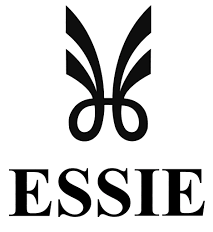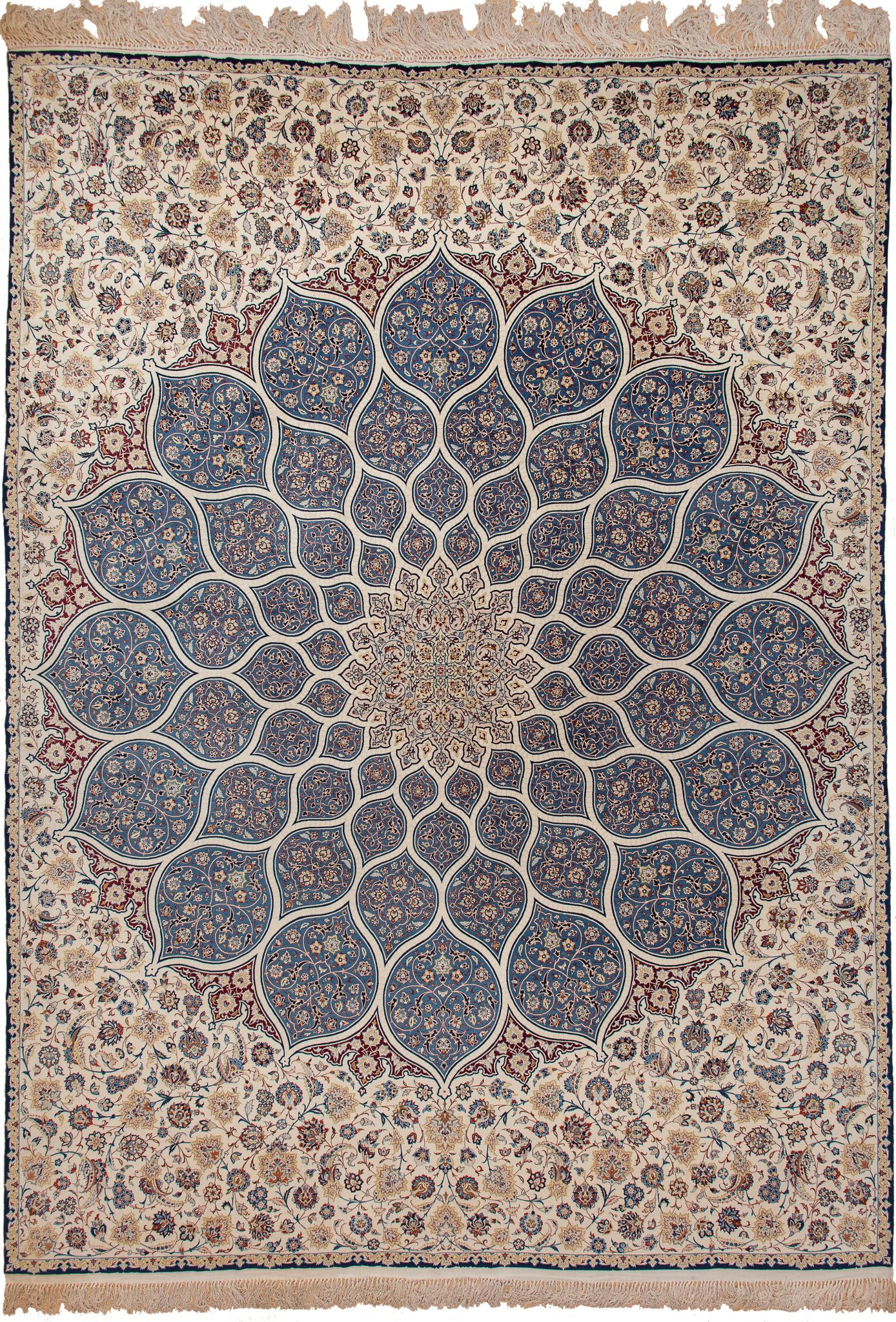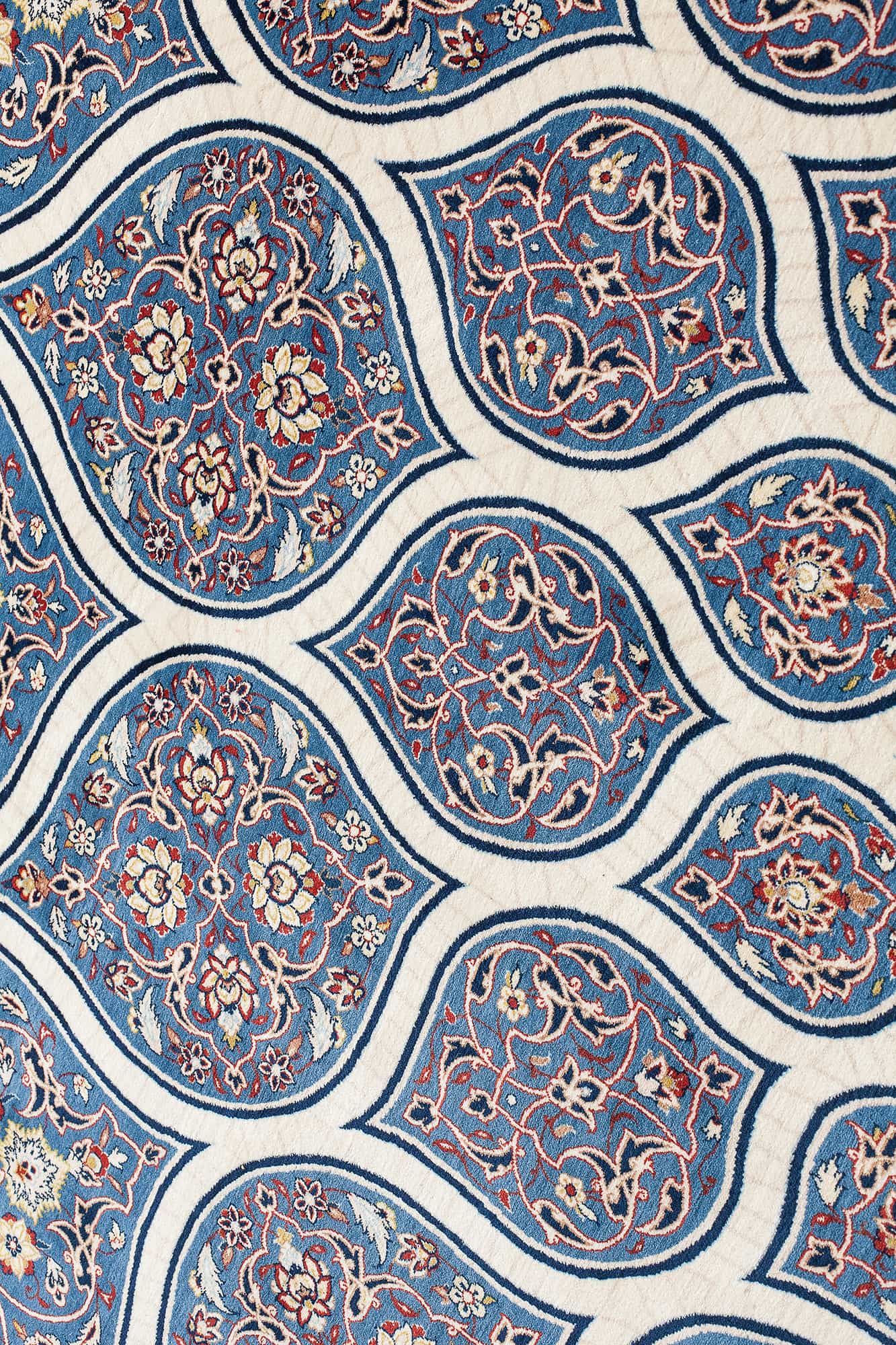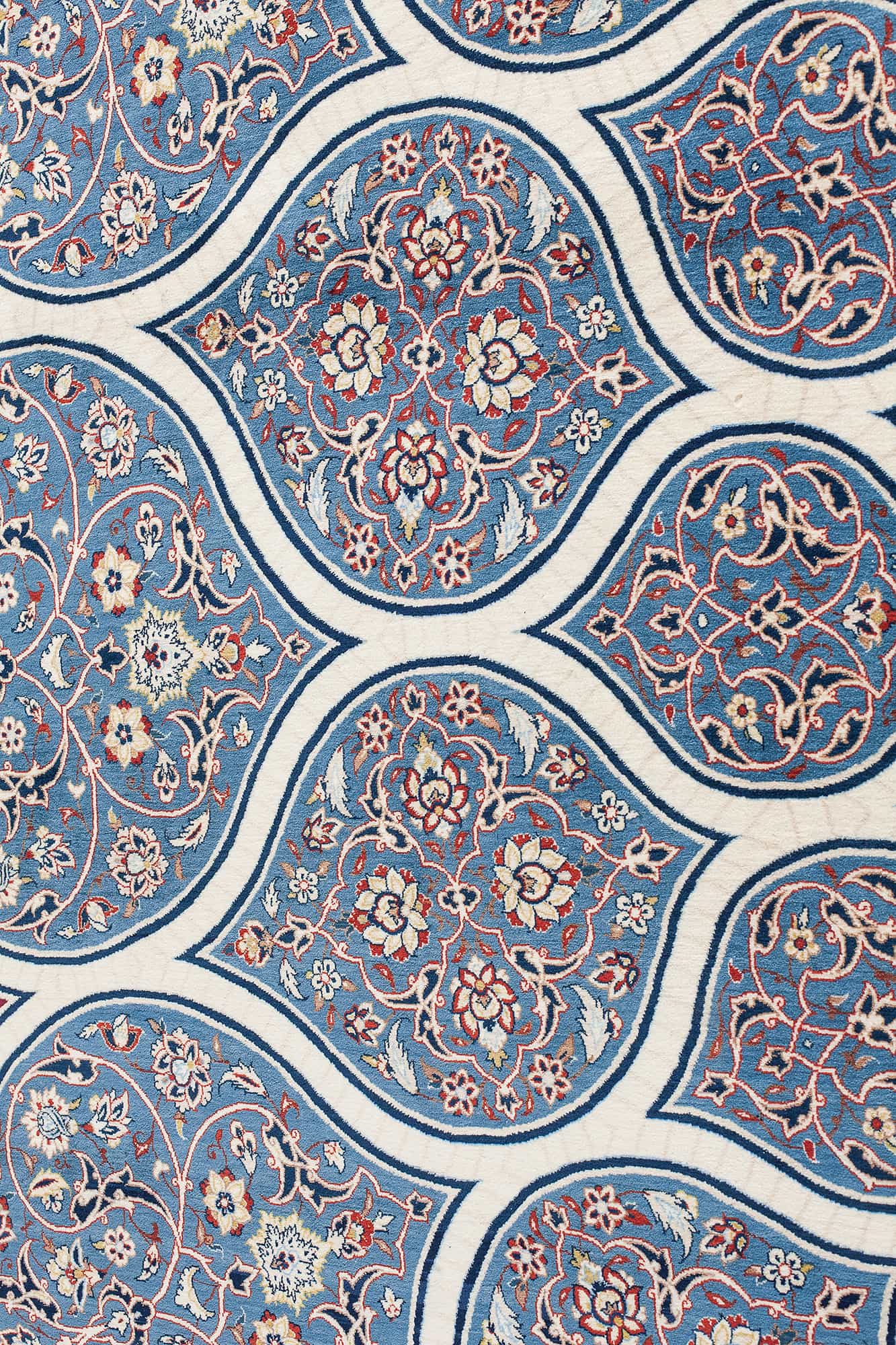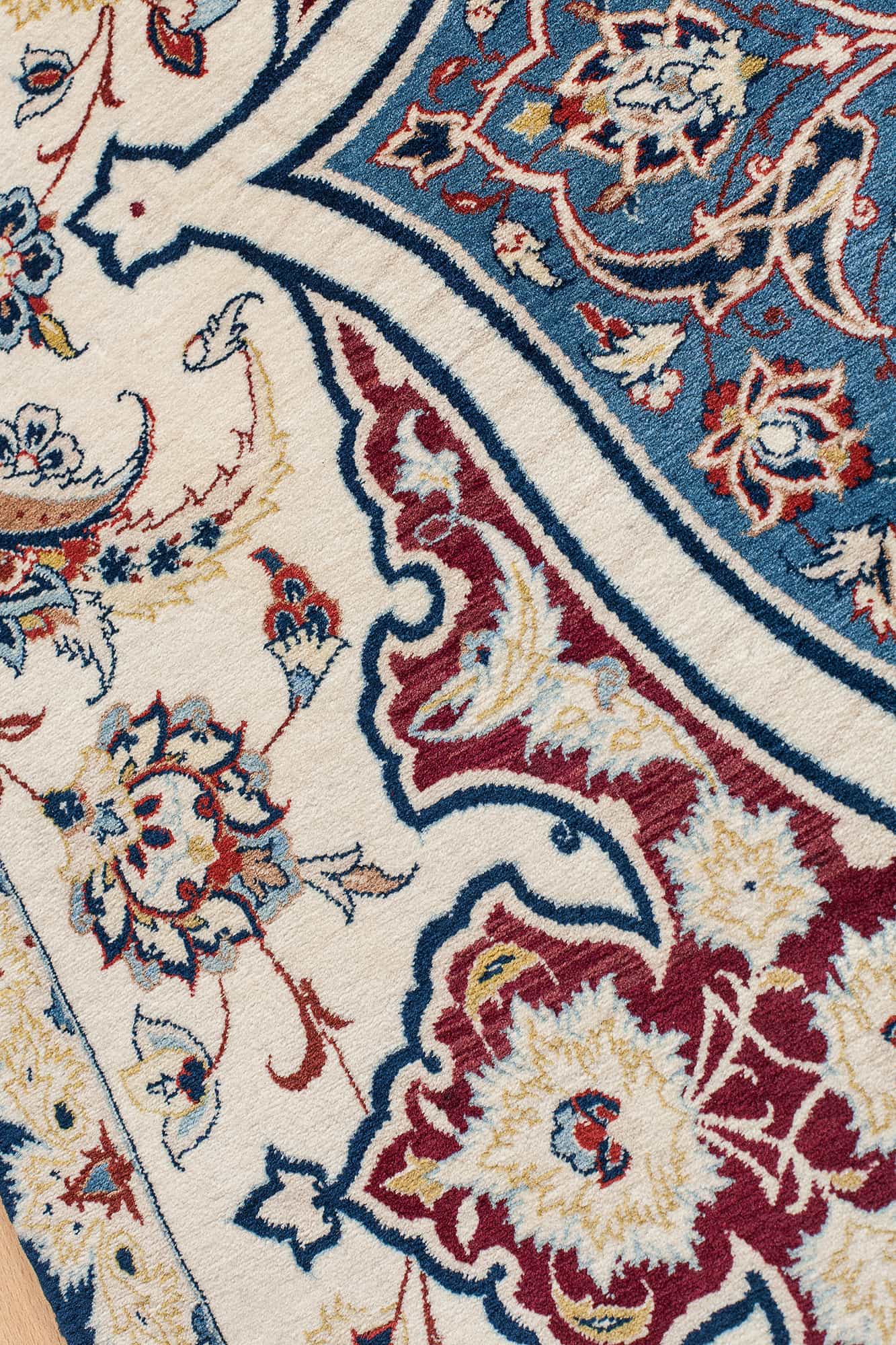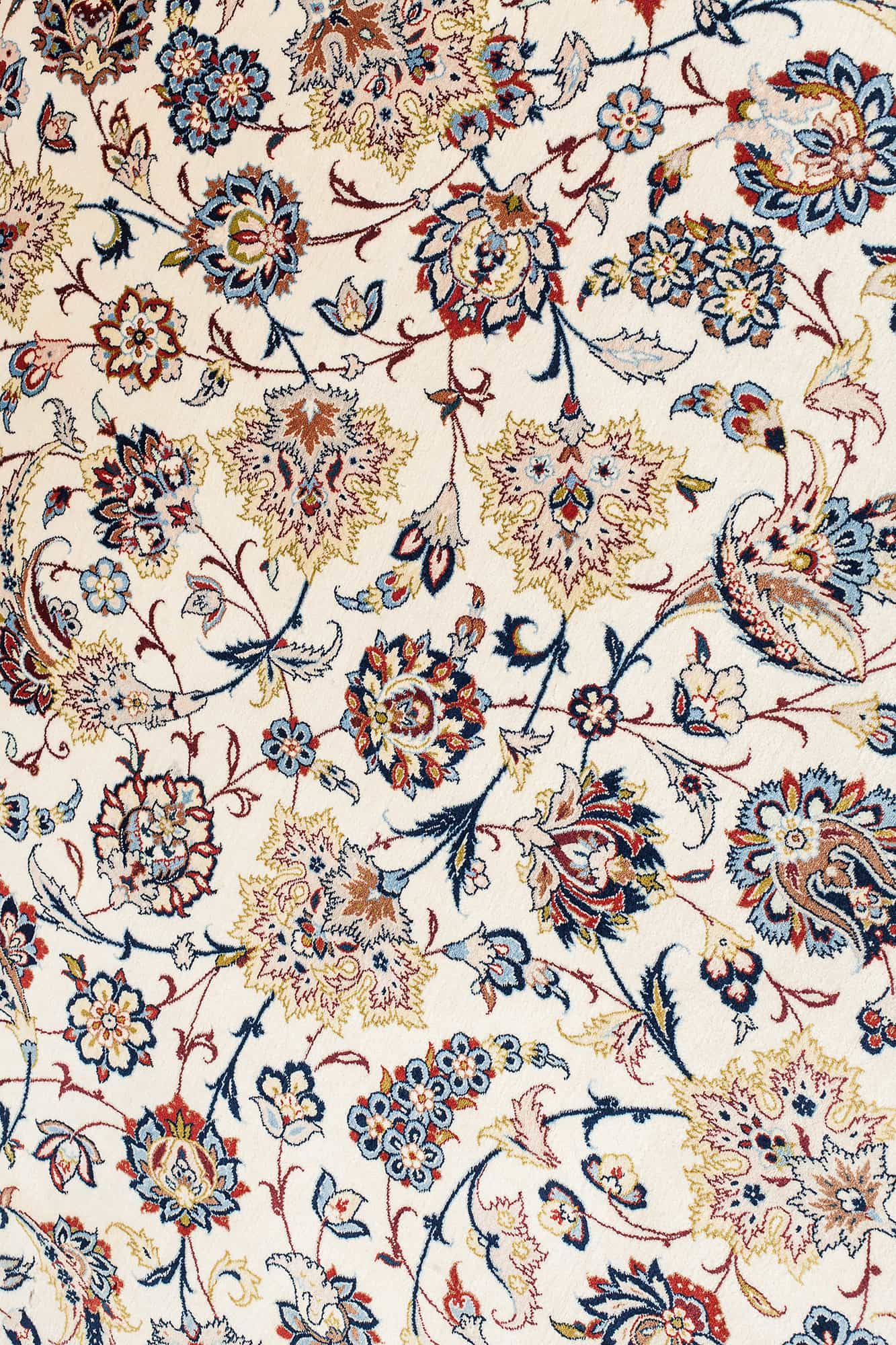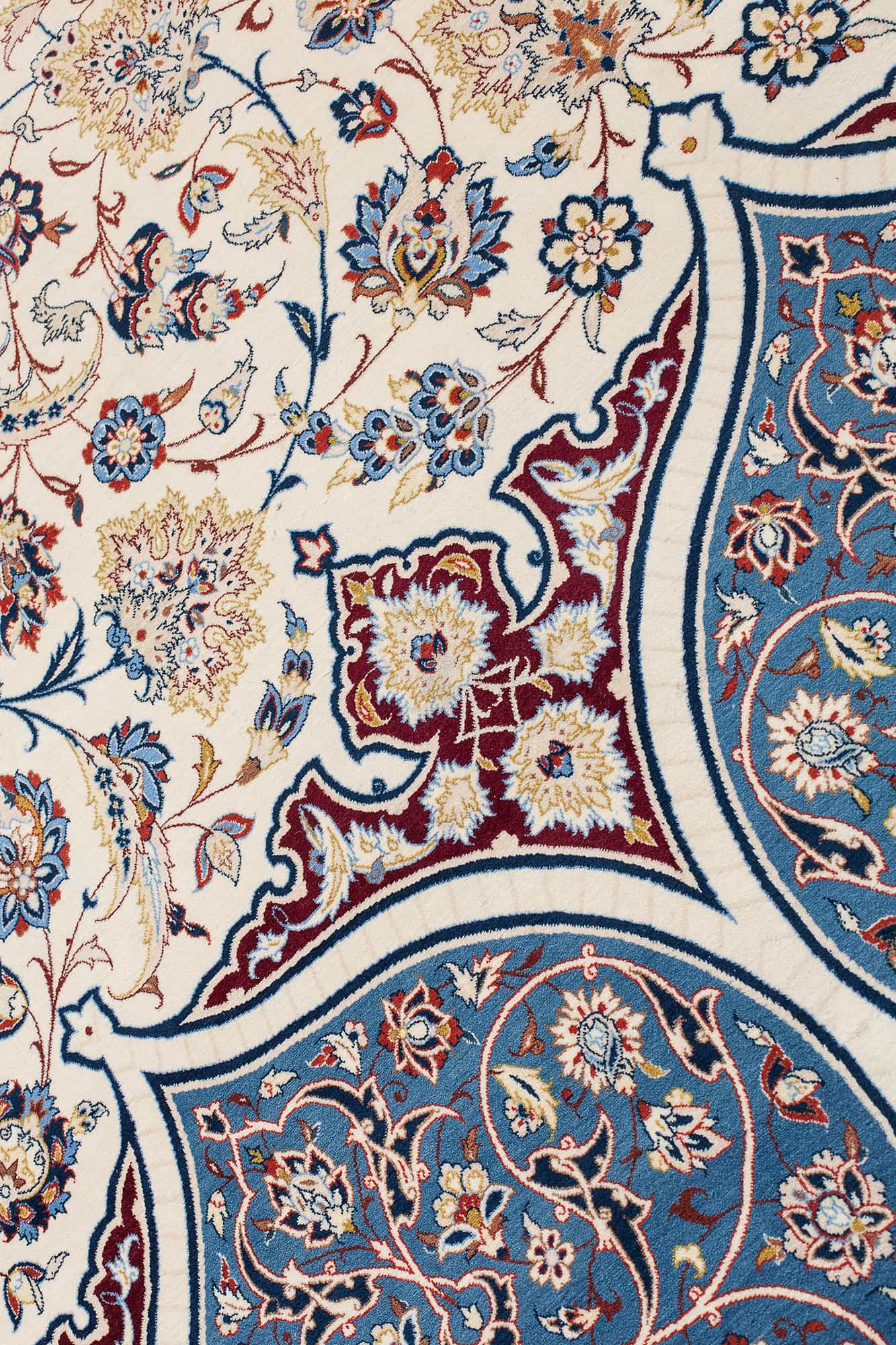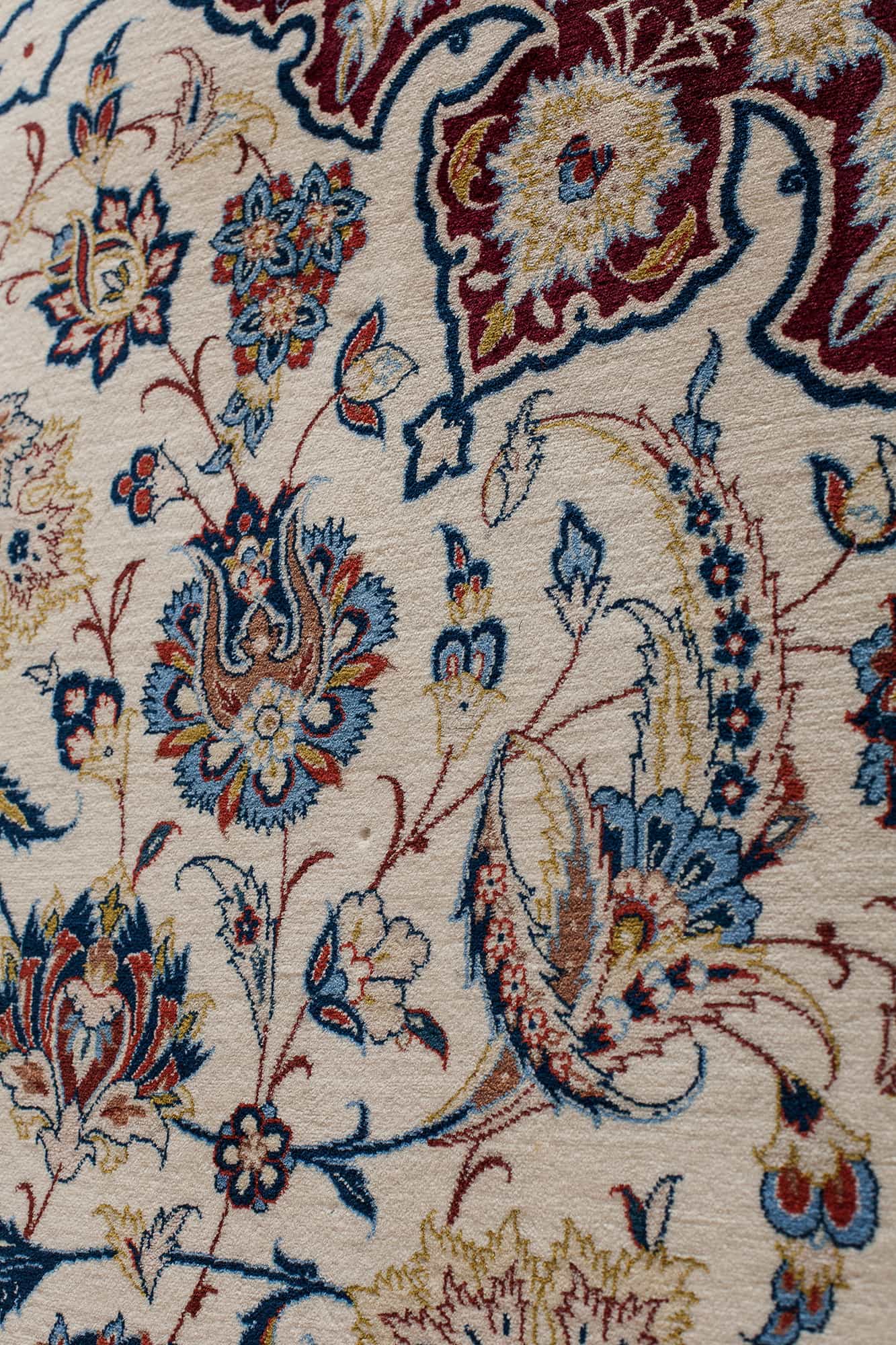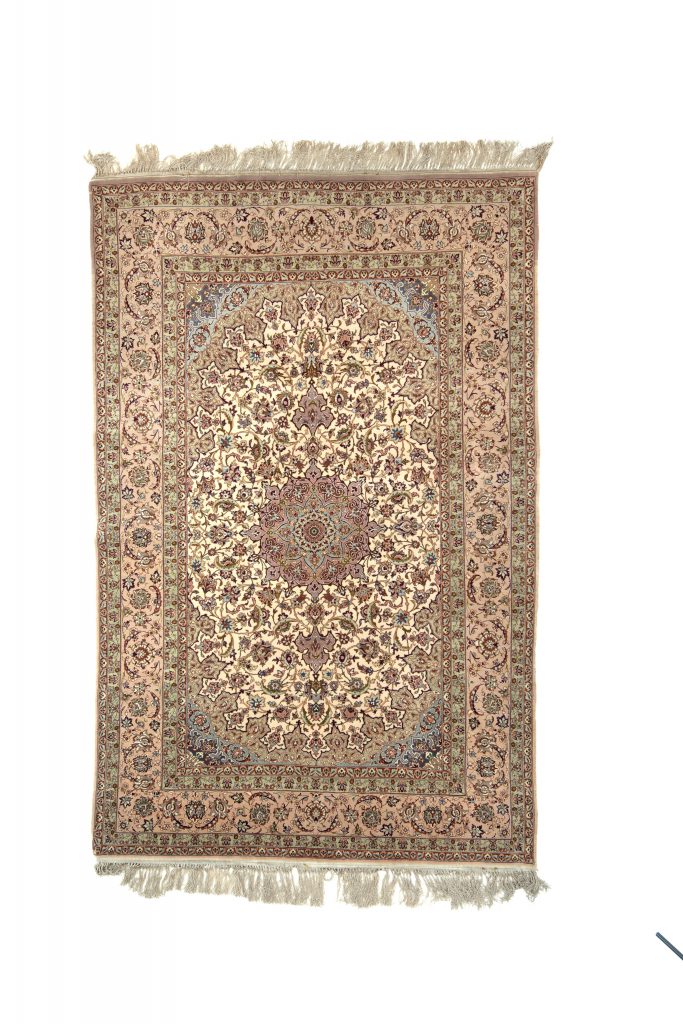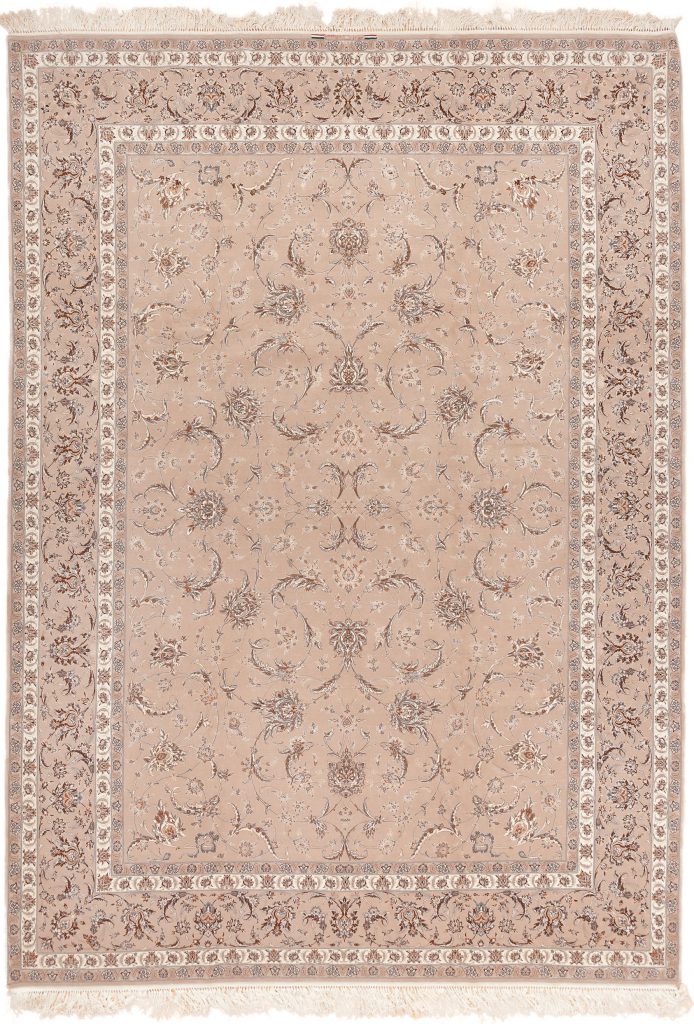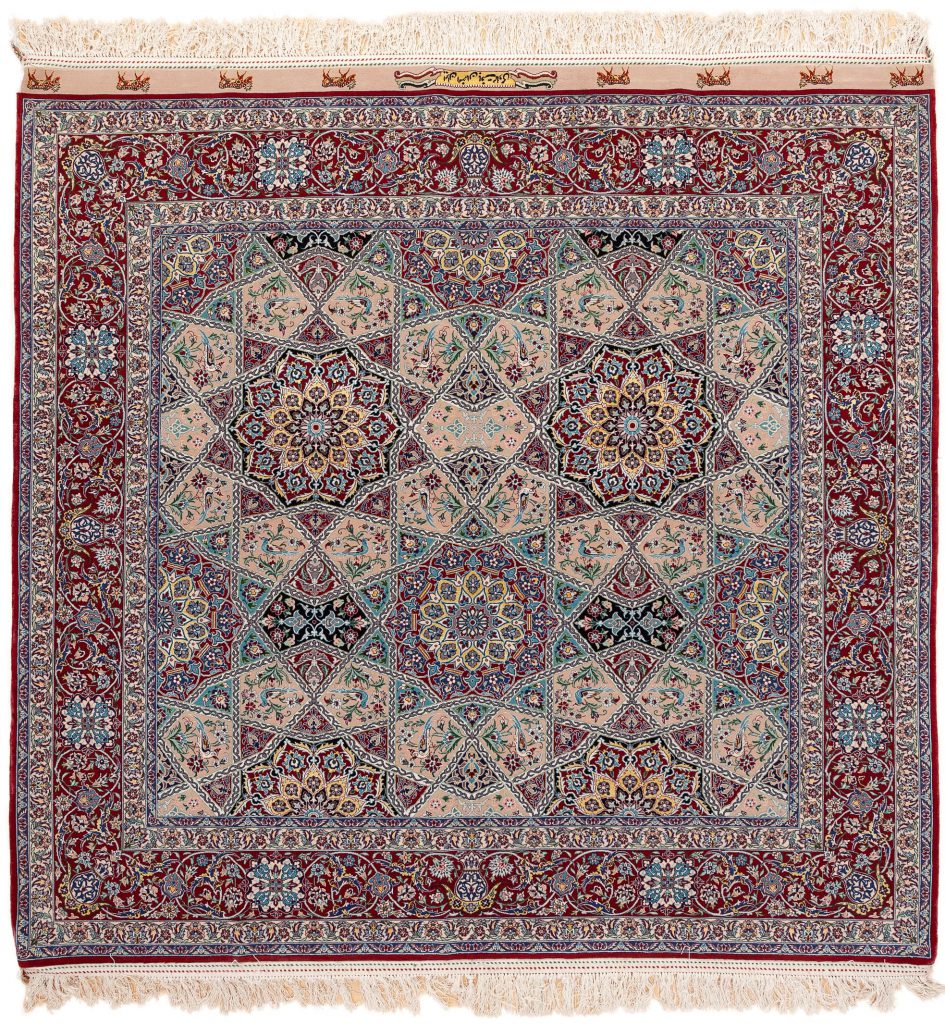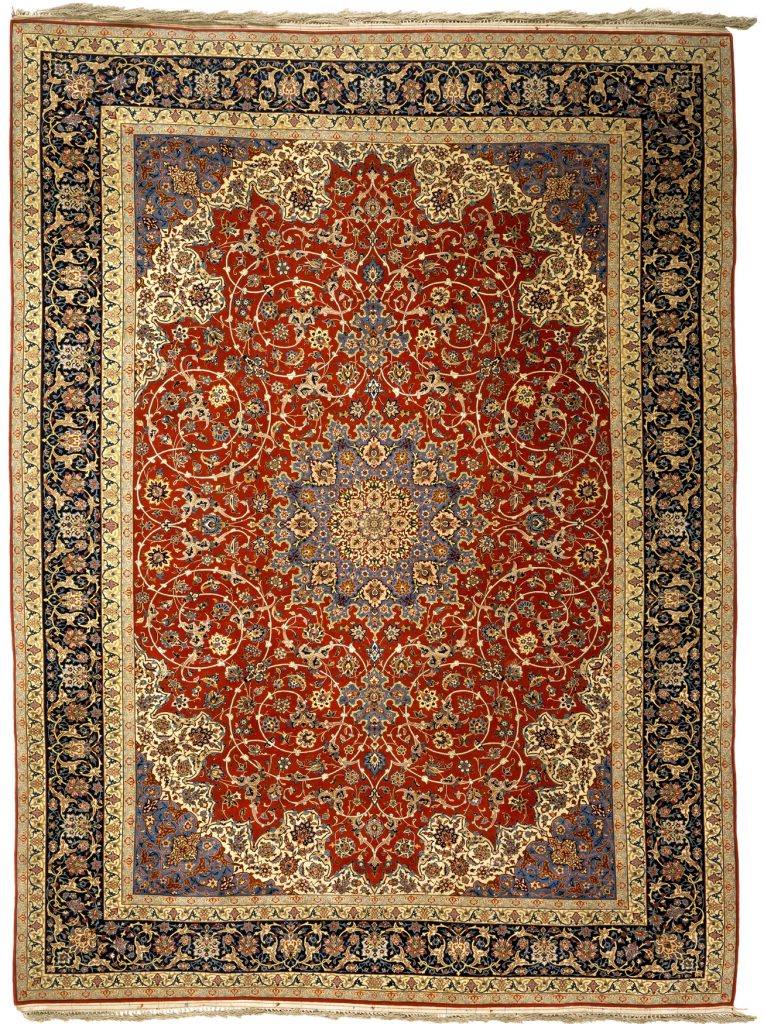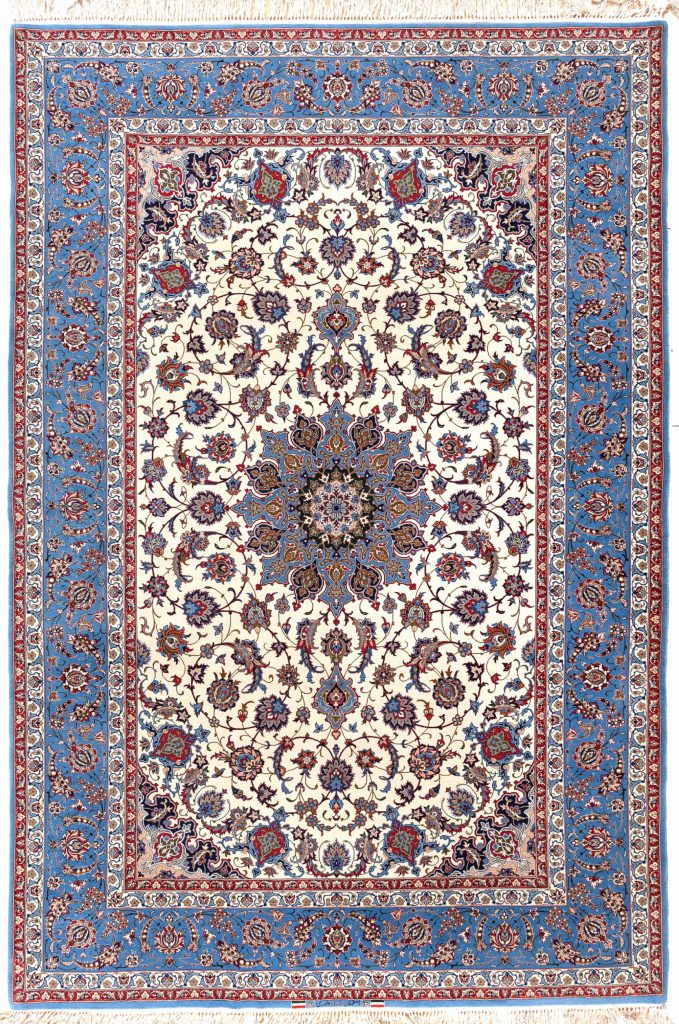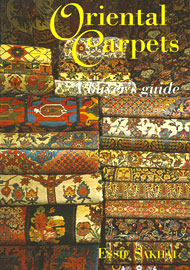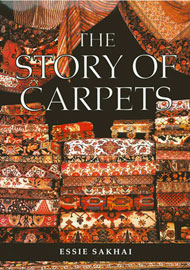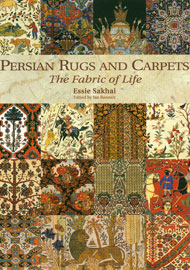Exquisite Unique Fine Persian Esfahan Carpet
Rug #1390A Fine Persian Esfahan Carpet, Central Persia, Kork Wool on Silk Foundation
Mid 20th Century
With a fine architectural design, the ivory field with a central ivory and pale blue scrolling arabesque and palmette star medallion radiating four layers of offset pale blue teardrop pendants each enclosing scrolling arabesques, palmettes and flower heads framed by interlocking red winged pendants supported by layered scrolling curvilinear vines issuing palmettes, flower heads and sets of curled serrated leaves within a narrow blue border enclosing continuous hooked vines
From the second half of the 19th Century there began resurgence in fine Persian carpet weaving, and by 1910 the industry was back in prominence. The ‘Revival’ of Persian excellence recalling the ‘Golden Era’ of magnificent 16th and 17th century carpet production was well under way. This transpired due to a return to Royal Patronage of the Arts under the auspices of Nasr al-Din Shah of the Qajar Dynasty, ruled 1848-1896 through to the present day. This resurgence was also enhanced by a return of interest, now to a wider Western market as a result of Industrial growth which created a considerably larger potential wealthier clientele. The major traditional Persian urban centres, including Tabriz, Isfahan, Kashan, Kerman, Meshed, for example responded to this new and significant interest, not only striving to recreate the magnificent styles of carpet design established in the 16th and 17th Centuries, but also looking at new sources of inspiration for carpet designs. The accent on striving for excellence recalling the exemplary standards of the 16th and 17th Century, the ‘Golden Age’ of carpet production, always in mind.
This magnificent Persian Esfahan carpet dating to the mid 20th Century exhibits true characteristics of this ‘revivalist’ approach to rug design made with the best possible quality materials. the design displays an architectural pattern based on the elaborate interior decoration of a tin glazed ceramic tiled mosque domed ceiling or interior arch. these tiles are ornately decorated in bright colours displaying traditional floral forms similar to those seen in carpet pattern details. 16th and 17th century Persian architectural ceilings, arches and walls were invariably embellished in this way. Historic Esfahan mosques displaying such elaborate and stunning decoration include the shah mosque 1629, Janchi mosque 1610, Sheikh Lotf Allah Mosque 1618, and the Khaju bridge 1650, which was constructed with twenty four highly decorated arches constructed under the auspices of Shah Abbas II around 1650. all these wonderful constructions would inevitably have been used as inspiration for the weavers of exceptionally fine Persian Esfahan carpets in classical times and in the finest 20th century revivalist times as is clearly the case in this striking impressive Persian Esfahan carpet. The definition of the pattern details are beautifully drawn artistically and cleverly arranged with the central star woven with intricate floral details surrounded by the blue pendants radiating from small to large, to create a large medallion, each pendant also enclosing extremely detailed flowing floral arabesque scrolls. this large circular medallion overlaid on a formal arrangement of a classical Safavid Persian pattern comprising two tiered meandering scrolling curvilinear vines adorned with beautifully drawn classical palmettes of varying forms supported by similarly technically finely drawn flower heads and leaves, all presented in delicate complementary colours with shades of ochre, pale blue and red detailing, typically seen colours from the 20th century Esfahan palette. The scale of the overall background pattern elements serves to enhance the importance and focus on the central medallion. Normally a broad main border with a complementary floral pattern would be present to frame the main action in the field area, however its absence only serves to enhance further the power and significance of the central medallion.
There is no doubt that the composition of this carpet is an artistic triumph, consistent with the very best of Persian Esfahan carpet workmanship of the 20th century.

Delivery
Delivery
Enjoy Complimentary Express Delivery at Checkout
Free express next-day delivery on all UK orders.
Free express delivery on all international orders above £2,000.
Estimated Delivery Times
Please allow between 1-3 days for UK, Europe and United States destinations and 5-7 days for Far East, South America, Middle East destinations.
Please note that orders placed after 12pm (UK time), on the weekend, or during holidays will be processed on the following business day. You will be provided with a shipping tracking number once your order has been shipped.
Collection from our Mayfair London showrooms
In-store collection will be ready within 1 business day. To collect in-store you will be required to show confirmation e-mail, official photo ID (passport or driving license) and the payment card used for the order. If someone else is collecting on your behalf, please make sure they bring a letter of authorisation that permits this person to collect on your behalf, official photo ID of the purchaser and of the person collecting and confirmation e-mail.

Exchanges
Exchanges
Essie Carpets offers clients a lifetime exchange service on any items purchased from us should you wish to change your carpets at any time in the future, subject to the item being in good condition; this can be particularly useful when redecorating your home, or when an upgrade in type or quality is desired.

Payment
Payment
Payments are accepted via credit card or debit card with a valid billing and shipping address*. Accepted credit cards are Visa, American Express, and Mastercard. When placing an order, your billing address must correspond to the address of your credit card, or we will not be able to process your order.
Bank Transfers are also accepted; in order to pay by Bank Transfer, please contact our Client Services via telephone at +44 20 7493 7766 or e-mail at sales@essiecarpets.com.
All transactions are secured. The Essie Carpets website is provided with an SSL encryption system to protect personal and payment data.
Similar Carpets
-
 Fine Persian Esfahan Rug 235 x 154 cm
Fine Persian Esfahan Rug 235 x 154 cmRug #5283 Fine Persian Esfahan Rug POA
Fine Persian Esfahan Rug
-
 Exquisite Fine Esfahan Carpet -Signed 347 x 247 cm
Exquisite Fine Esfahan Carpet -Signed 347 x 247 cmRug #2654 Exquisite Fine Esfahan Carpet -Signed POA
Exquisite Fine Esfahan Carpet -Signed
-
 Magnificent Fine Rare Esfahan Rug - Signed - Square 215 x 210 cm
Magnificent Fine Rare Esfahan Rug - Signed - Square 215 x 210 cmRug #2651 Magnificent Fine Rare Esfahan Rug - Signed - Square POA
Magnificent Fine Rare Esfahan Rug – Signed – Square
-
 Magnificent Esfahan Carpet - Square 318 x 305 cm
Magnificent Esfahan Carpet - Square 318 x 305 cmRug #2633 Magnificent Esfahan Carpet - Square POA
Magnificent Esfahan Carpet – Square
-
 Extremely Fine Persian Esfahan Carpet 365 x 276 cm
Extremely Fine Persian Esfahan Carpet 365 x 276 cmRug #5133 Extremely Fine Persian Esfahan Carpet POA
Extremely Fine Persian Esfahan Carpet
-
 Fine Persian Isfahan Rug - Silk and Wool - Signed 295 x 196 cm
Fine Persian Isfahan Rug - Silk and Wool - Signed 295 x 196 cmRug #2612 Fine Persian Isfahan Rug - Silk and Wool - Signed POA
Fine Persian Isfahan Rug – Silk and Wool – Signed
